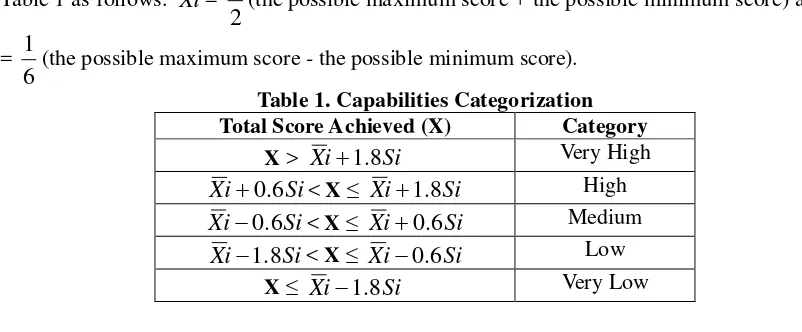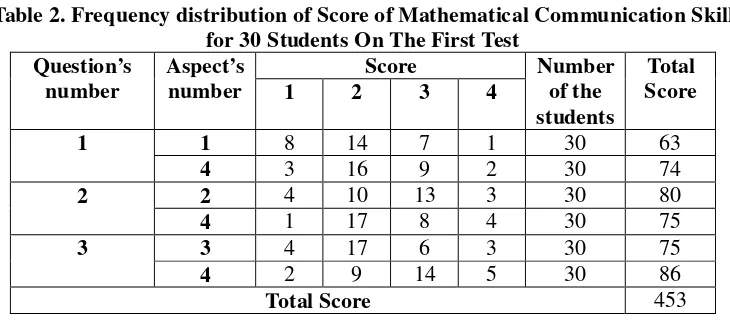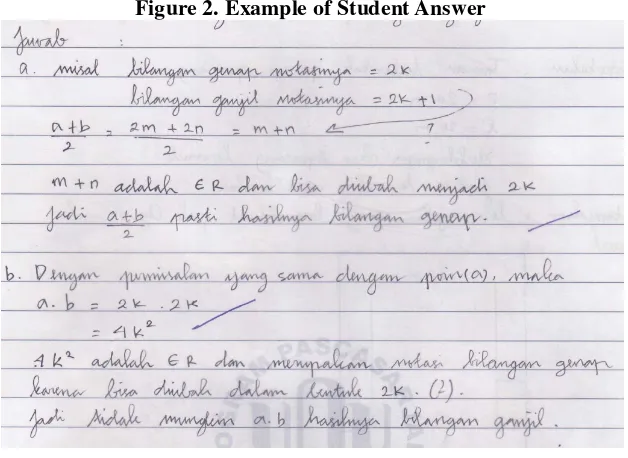ME – 18
MATHEMATICAL COMMUNICATION SKILLS
FOR POSTGRADUATE STUDENT OF PRIMARY EDUCATION
STUDY PROGRAM: A CASE STUDY
Djamilah Bondan Widjajanti
Mathematics Education Department, Mathematics & Natural Science Faculty Yogyakarta State University, Indonesia
Abstract
The purpose of the research is to identify which aspects of the communication skills of the postgraduate student of Primary Education Study Program that needs to be improved. The subjects of the research were 30 students of Postgraduate Student of Primary Education Study Program, State University of Yogyakarta, Indonesia, who took Mathematics course from September to December, 2014.
The instruments used to collect the data were in form of Mathematics questions/problems. There were 3 times tests over a period of September – December 2014, each consists of 3 questions. There were 4 aspects that were assessed, namely: (1) the accuracy, coherently, and clarity of the reasons used in answering the question; (2) the clarity of the drawing/illustrations used; (3) The appropriateness and the completeness of mathematical models/equations used, and (4) the accuracy of the phrase used in answering the question.
This research shows: (1) The mathematical communication skills of the postgraduate student of Primary Education Study Program, Yogyakarta State University, who were the subject of this research are classified as "medium"; (2) The accuracy, coherently, and clarity of the reasons used in answering the question and the accuracy of the phrase used in answering the question tend to be in the category of "medium" constantly; (3) The clarity of the drawing/illustrations used and the appropriateness and the completeness of mathematical models/equations used has a tendency to be included in the high category. Thus, aspects that still need to be improved mainly are: (1) ) The accuracy, coherently, and clarity of the reasons used in answering the question; and (2) The accuracy of the phrase used in answering the question.
Key words: communication, mathematics, postgraduate, primary, education
INTRODUCTION
Mathematical communication skills play a very important role in mathematics class. It is an essential part of mathematics and mathematics education (NCTM, 2000; Wichlt, 2009). Mathematical communication skills is an essential process for learning mathematics because through communication, students reflect upon, clarify and expand their ideas and understanding of mathematical relationships and mathematical argument (Ontario Ministry of Education, 2005).
having the mathematical communication has become one of the goals of mathematics are given at schools (Har, 2007; Lim & Chew, 2007; Ulep, 2007). In Japan, mathematical communication is not explicitly in the curriculum, but an important part of the problem-solving activities (Isoda, 2007) and is emphasized in the classrooms (Khaing, Hamaguchi, Ohtani, 2007).
For students, involving in mathematical communication, either with teacher or his friends, either orally or written, either at the same time with the learning process or outside the class, will give many advantages to improve his mathematical understanding (NCTM, 2000). In addition, the use of mathematical language helps students gain insights into their own thinking and develop and express their mathematical ideas and strategies, precisely and coherently, to themselves and to others (Walk, Congress, Bansho, 2010).
For mathematics teachers, the skill of mathematical communication is not only important for their self, but it is also important for their students. We can imagine the effect that will happen if the mathematics teacher cannot communicate their mathematical thinking to their students in the learning process in the class. As example: (1) teacher cannot give an explanation for the student’s question “why is it so?”; (2) teacher writes some unsorted sequences/not logical of steps to proof or to solve a problem; (3) teachers uses mathematics notation inconsistently; or (4) teacher draws geometric shape that is not quite right. Such thing can be the causes of why there are many students including elementary school students who, think that mathematics is a very difficult subject (Djamilah, 2013).
If the mathematics teacher in elementary/primary school are able to communicate the mathematical concept, principles or procedure clearly and systematically, to use the terms/terminology and notation consistently and if they are able to give logical explanation according each student’s level of thinking, it is probable that students can get the impression that mathematics is an easy lesson. Therefore, it becomes very important for prospective mathematics teachers in primary/elementary school to have a good mathematical communication skill. Included in the prospective mathematics teachers in primary schools are Postgraduate Student of Primary Education Study Program.
Given the importance of a mathematics teacher to have an adequate skill of mathematical communication, thus the education program for Postgraduate Student of Primary Education should define a standard for this skill. In order to improve the communication skill for Postgraduate Student of Primary Education Study Program, firstly, it needs to be identified which aspect that need to be improved. For this purposes, this descriptive research was conducted. More specifically, this research aims to identify mathematics student’s weaknesses in communication skills.
RESEARCH METHOD
The type of this research is descriptive. The purpose of the research is to identify which aspects of the communication skills of the postgraduate student of Primary Education Study Program that needs to be improved. The subjects of the research were 30 students of Postgraduate Student of Primary Education Study Program, State University of Yogyakarta, Indonesia, who took Mathematics course from September to December, 2014.
The instruments used to collect the data were in form of Mathematics questions/problems. There were 3 times quizzes/tests over a period of September – December 2014, each consists of 3 questions. So in total there are 9 questions about the mathematical communication skills. Some example of mathematical communication questions/problems that are given to the students is as follows.
No 1. Jika a dan b merupakan bilangan genap, jelaskan: (1) apakah
2
b
a
pasti
bilangan genap?; (2) apakah mungkin a.b bilangan ganjil?
(If a and b are even numbers, explain: (1) Is
2
b
a
must be an even number? (2) Is it
Problem number 1 is intended to measure a student's ability to give an explanation. while the question number 2 is intended to measure students' skills in making drawings or illustrations.
No 2. Pak Agus sedang merancang sebuah taman bunga yang berbentuk persegi dengan panjang 30m dan lebar 20m. Sekelililing taman tersebut ingin diberi jalan yang dipasangi keramik motif khusus dengan ukuran 1m2/keramik, namun stok keramik yang ia inginkan di toko tinggal 600 lembar.. Berapa lebar jalan yang bisa dibuat oleh Pak Agus?
(Mr. Agus are designing a square-shaped flower garden with 30m long and 20m wide. He wants to build a road around that garden and gives a specific kind of ceramic with size 1 m2/ceramics, but ceramics stock he wants in store only 600 pieces. What is the width of the road that could be made by Mr. Agus? )
Problem number 3, which is intended to measure student's ability to write equations or mathematical model is as follows.
No 3. Andi biasa berolah raga jalan dan lari pagi setiap hari Minggu pagi. Jarak yang ia tempuh sejauh 10km. Andi berjalan dengan kecepatan 4km/jam, dan berlari dengan kecepatan 8km/jam. Hari ini Andi berolah raga pagi selama 2 jam 15 menit. Tentukan berapa lama Andi berjalan dan berapa lama ia berlari pagi ini.
(Andi always walks and jogs regularly every Sunday morning. The distance that he traveled along the 10 miles. Andi walks at a speed of 4km/h, and runs at a speed of 8km /h. Today, Andi exercised in the morning for 2 hours 15 minutes. Determine how long Andi walked and how long he ran this morning.)
To identify the aspects of weaknesses of students, the researcher prepared the assessment rubric for the mathematical communication skills. There were 4 aspects that were assessed, namely: (1) the accuracy, coherently, and clarity of the reasons used in answering the question; (2) the clarity of the drawing/illustrations used; (3) The appropriateness and the completeness of mathematical models/equations used, and (4) the accuracy of the phrase used in answering the question. Score each aspect is 1, 2, 3, or 4.
From the data collected, it will describe: (1) category of the mathematical communication skills of students who were the subjects of this research, (2) the aspects in which students tend to be weak, (3) examples of mistakes made by students. Guidelines for the categorization of mathematical communication skills according Widoyoko, E. P. (2009) are in
Table 1 as follows.
X
i
=2
1
(the possible maximum score + the possible minimum score) and Si
=
6
1
(the possible maximum score - the possible minimum score).
Table 1. Capabilities Categorization
Total Score Achieved (X) Category
X >
X
i
1
.
8
Si
Very HighSi
i
X
0
.
6
< X ≤X
i
1
.
8
Si
HighSi
i
X
0
.
6
< X ≤X
i
0
.
6
Si
MediumSi
i
X
1
.
8
< X ≤X
i
0
.
6
Si
LowRESULT AND DISCUSSION
Table 2 below represents the frequency distribution of scores achievement of mathematical communication skills in the first test.
Table 2. Frequency distribution of Score of Mathematical Communication Skill for 30 Students On The First Test
Question’s number
Aspect’s number
Score Number
of the students
Total Score
1 2 3 4
1 1 8 14 7 1 30 63
4 3 16 9 2 30 74
2 2 4 10 13 3 30 80
4 1 17 8 4 30 75
3 3 4 17 6 3 30 75
4 2 9 14 5 30 86
Total Score 453
From the data in Table 2, it was obtained total score of 30 students in 3 questions is 453 for the maximum possible total score of 6430 = 720. These results are included in the category of "medium". Total score for the first aspect is 63 from a possible maximum total score of 120. These results are included in the category of "low". Total score for the second aspect is 80 from a possible maximum total score of 120. These results are included in the category of "medium". Total score for the third aspect is 75 from a possible maximum total score of 120. These results are included in the category of "medium". Whereas for the fourth aspect, a total score is (74 + 75 + 86 ) = 235 from a possible total score of 360, included in the category of "medium".
In the second and third tests, each using 3 problems, which obtained the results as in
Table 3 below.
Table 3. Total Score and Category of Mathematical Communication Skills for 30 Students on The Second and Third Test
Aspect’s number
Total Score On Second Test
Category Total Score
On Third Test
Category
1 70 medium 75 medium
2 81 medium 85 high
3 82 medium 87 high
4 240 medium 247 medium
Total 473 medium 494 medium
Considering the results of the three tests as shown in Table 2 and Table 3, it can be concluded that the mathematical communication skills of the postgraduate student of Primary Education Study Program who were the subjects of this research are included in "medium" category. However, if the result of each aspect is observed, the second aspect namely “the clarity of the drawing/illustrations used”, and the third aspect, namely “The appropriateness and the completeness of mathematical models/equations used” has a tendency to be included in the high category. While the first and fourth aspects, namely “The accuracy, coherently, and clarity of the reasons used in answering the question" and "the accuracy of the phrase used in answering the question", tend to be in the category of "medium" constantly.
especially in giving a reason. For example, in answer to Question 1 . Two examples of a student answers is seen in Figure 1 and Figure 2 as follows.
Figure 1. Example of Student Answer
The answer to this question is
2
b
a
is not necessarily an even number. Because there
are even numbers a = 2 and b = 4, such that
2
b
a
= 3, an odd number. The student gave the
reason that
2
b
a
definitely even number because all the numbers are divisible by 2 is an even
number, but she/he did not associate with the possibility of m + n is an odd number. Figure 2 shows one example of another wrong answer.
Figure 2. Example of Student Answer
Of the two examples of these answers can be seen that mathematical communication skills of students associated with the student conceptual understanding of the even and odd numbers. For postgraduate students, there is a misconception is like this is very worrying.
Figure 3. Example of Student Answer
Figure 4. Example of Student Answer
To answer question number 3, Figure 5 is an example of the lack of proper answer in making the statement for x and y.
Figure 5. Example of Student Answer
Figure 6. Example of Student Answer
The results of this study is similar to the research result of Djamilah (2013) for the graduate student of Mathematics Education Study Program, which is that students tend to be
weak in (1) writing down the reasons, (2) using charts, pictures, and illustrations, and (3)
developing a mathematical model. Things that are suspected to be the cause of the error as described above is their learning experience at school level before, that they are less accustomed to write with complete answers and less accustomed to convey the idea to their friends or their teachers. This means that it is necessary for mathematics teachers to train their students to answer questions in complete sentences, make the appropriate illustration, and using the notation or symbols correctly. The accuracy of the use of the notation/symbols become important in mathematics, because it is very much a function of the notations/symbol. Inaccuracies in the use of notations/symbols can lead to misconceptions (Skemp, 1971).
CONCLUSION AND SUGGESTION
This research shows: (1) mathematical communication skills of the postgraduate student of Primary Education Study Program, Yogyakarta State University, who were the subject of this research are classified as "medium"; (2) The first and fourth aspects, namely “The accuracy, coherently, and clarity of the reasons used in answering the question" and “The accuracy of the phrase used in answering the question", tend to be in the category of "medium" constantly; (3) The second aspect namely “the clarity of the drawing/illustrations used”, and the third aspect, namely “The appropriateness and the completeness of mathematical models/equations used” has a tendency to be included in the high category. However, some examples of student errors is quite apprehensive, considering they had a postgraduate student.
Based on these results, the recommended solution for improving the mathematical communication skills of the postgraduate student of Primary Education Study Program is the use of collaborative problem-based learning strategy. Essentially, this strategy relies on the use of challenging problems to guide the lectures and to emphasize the collaboration between students in solving some problems given by the lecturer. With such strategy, students have some opportunities to practice more often using some charts/pictures/illustrations, making some reasons/explanations, and to develop some mathematical models from a given problem. The research of Djamilah (2010) shows the superiority of collaborative problem-based learning strategy compared to conventional strategies, particularly in promoting mathematical communication skills of prospective mathematics teacher.
REFERENCES
Djamilah Bondan Widjajanti. 2010. Analisis Implementasi Strategi Perkuliahan Kolaboratif Berbasis Masalah dalam Mengembangkan Kemampuan Pemecahan Masalah Matematis, Kemampuan Komunikasi Matematis, dan Keyakinan terhadap Pembelajaran Matematika. Disertasion. Bandung: Universitas Pendidikan Indonesia.
Prospective Mathematics Teacher:A Case Study on Mathematics Education Students, Yogyakarta State University, Indonesia.Online in Jurnal Teknologi (Social Sciences) 63:2 (2013), 39–| www.jurnalteknologi.utm.my | eISSN 2180–3722 | ISSN 0127–9696
Har,Y. B. 2007. The Singapore Mathematics Curriculum and Mathematical Communication. Paper presented at APEC-TSUKUBA International Conference III, December 9-14, 2007, Tokyo Kanazawa and Kyoto, Japan.
Isoda, M. 2007. How can we develop classroom communication? With an example of classroom dialectic. Paper presented at APEC-TSUKUBA International Conference III, December 9-14, 2007, Tokyo Kanazawa and Kyoto, Japan.
Khaing, T.T, K. Hamaguchi, and M. Ohtani, M. 2007. Development Mathematical Communication in the Classroom. Paper presented at APEC-TSUKUBA International Conference III, December 9-14, 2007, Tokyo Kanazawa and Kyoto, Japan.
Lim, C.H., and C.M. Chew. 2007. Mathematical Communication in Malaysian Bilingual Classroom. Paper presented at APEC-TSUKUBA International Conference III, December 9-14, 2007, Tokyo Kanazawa and Kyoto, Japan.
National Council of Teachers of Mathematics. 2000. Principles and Standards for School Mathematics. Reston: NCTM.
Ontario Ministry of Education . 2005. The Ontario Curriculum. Online in http://www.edu.gov.on.ca/eng/curriculum/elementary/math18curr.pdf.
Skemp, R. R. 1971. The Psychology of Learning Mathematics. Middlesex: Penguins Book.
Ulep, S.A. 2007. Developing Mathematical Communication in Philippine Classrooms. Paper presented at APEC-TSUKUBA International Conference III, December 9-14, 2007, Tokyo Kanazawa and Kyoto, Japan.
Walk, G., M. Congress, and Bansho . 2010. Communication in the Mathematics Classroom . Online in http://www.edu.gov.on.ca/eng/literacynumeracy/inspire/research/
Wichelt, L. 2009. Communication: A Vital Skill of Mathematics. Online in http://digitalcommons.unl.edu/mathmidactionresearch/18.
Widoyoko, E.P. 2009.Evaluasi Program Pembelajaran. Yogyakarta: Pustaka Pelajar.




